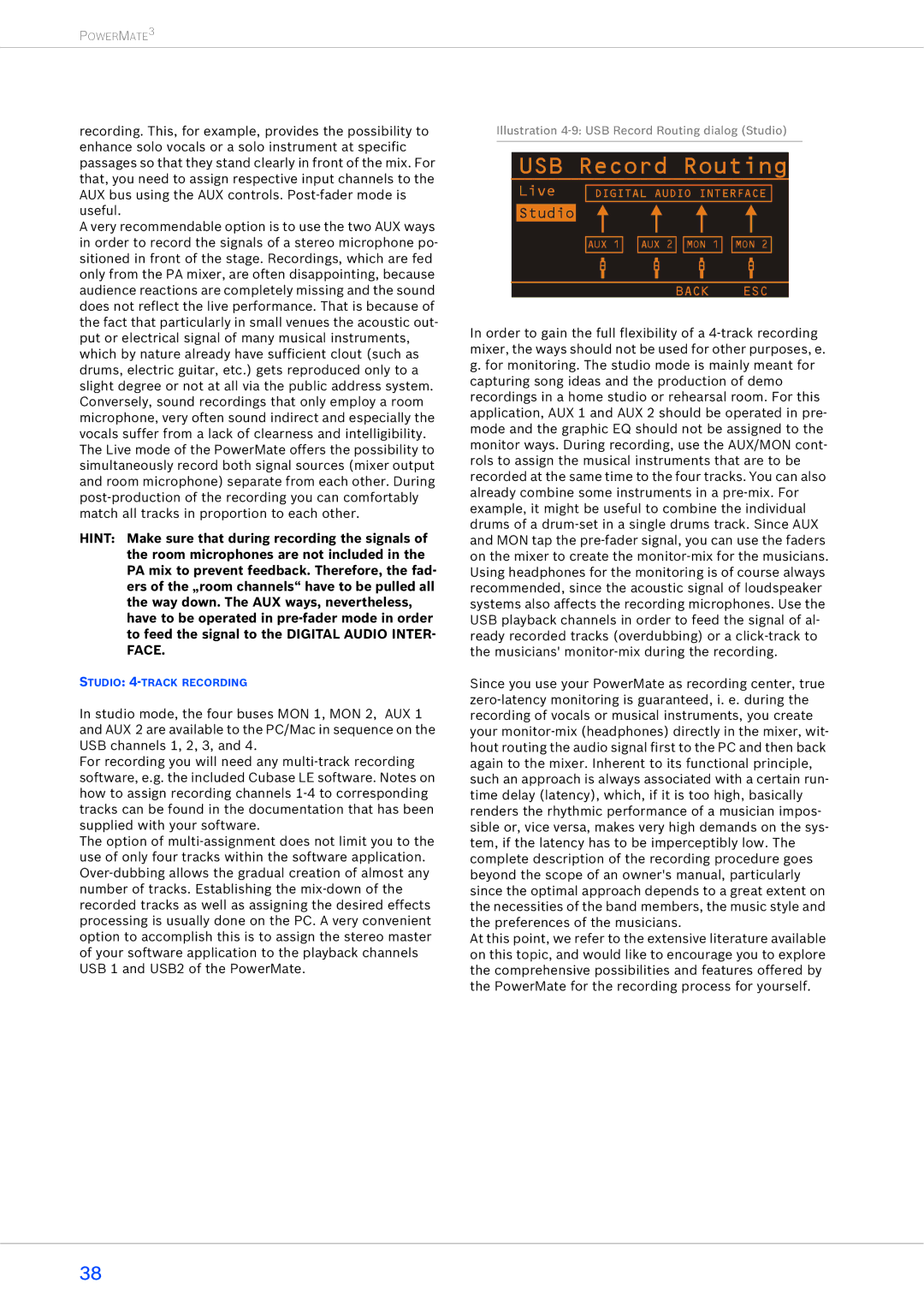recording. This, for example, provides the possibility to enhance solo vocals or a solo instrument at specific passages so that they stand clearly in front of the mix. For that, you need to assign respective input channels to the AUX bus using the AUX controls. Post-fader mode is useful.
A very recommendable option is to use the two AUX ways in order to record the signals of a stereo microphone po- sitioned in front of the stage. Recordings, which are fed only from the PA mixer, are often disappointing, because audience reactions are completely missing and the sound does not reflect the live performance. That is because of the fact that particularly in small venues the acoustic out- put or electrical signal of many musical instruments, which by nature already have sufficient clout (such as drums, electric guitar, etc.) gets reproduced only to a slight degree or not at all via the public address system. Conversely, sound recordings that only employ a room microphone, very often sound indirect and especially the vocals suffer from a lack of clearness and intelligibility. The Live mode of the PowerMate offers the possibility to simultaneously record both signal sources (mixer output and room microphone) separate from each other. During post-production of the recording you can comfortably match all tracks in proportion to each other.
HINT: Make sure that during recording the signals of the room microphones are not included in the PA mix to prevent feedback. Therefore, the fad- ers of the „room channels“ have to be pulled all the way down. The AUX ways, nevertheless, have to be operated in pre-fader mode in order to feed the signal to the DIGITAL AUDIO INTER- FACE.
STUDIO: 4-TRACK RECORDING
In studio mode, the four buses MON 1, MON 2, AUX 1 and AUX 2 are available to the PC/Mac in sequence on the USB channels 1, 2, 3, and 4.
For recording you will need any multi-track recording software, e.g. the included Cubase LE software. Notes on how to assign recording channels 1-4 to corresponding tracks can be found in the documentation that has been supplied with your software.
The option of multi-assignment does not limit you to the use of only four tracks within the software application. Over-dubbing allows the gradual creation of almost any number of tracks. Establishing the mix-down of the recorded tracks as well as assigning the desired effects processing is usually done on the PC. A very convenient option to accomplish this is to assign the stereo master of your software application to the playback channels USB 1 and USB2 of the PowerMate.
Illustration 4-9: USB Record Routing dialog (Studio)
USB Record Routing
| Live | | | |
DIGITAL AUDIO INTERFACE | |
| | | | | | | | | | | | | |
| Studio | | | | | | | | | | | | | |
| | | | | | | | | | | |
| | | | | | | | | | | | | | |
| | | | | | | | | | |
| | | AUX 1 | | AUX 2 | | MON 1 | | MON 2 | |
| | | | | | | | | | | | | | |
BACK ESC
In order to gain the full flexibility of a 4-track recording mixer, the ways should not be used for other purposes, e. g. for monitoring. The studio mode is mainly meant for capturing song ideas and the production of demo recordings in a home studio or rehearsal room. For this application, AUX 1 and AUX 2 should be operated in pre- mode and the graphic EQ should not be assigned to the monitor ways. During recording, use the AUX/MON cont- rols to assign the musical instruments that are to be recorded at the same time to the four tracks. You can also already combine some instruments in a pre-mix. For example, it might be useful to combine the individual drums of a drum-set in a single drums track. Since AUX and MON tap the pre-fader signal, you can use the faders on the mixer to create the monitor-mix for the musicians. Using headphones for the monitoring is of course always recommended, since the acoustic signal of loudspeaker systems also affects the recording microphones. Use the USB playback channels in order to feed the signal of al- ready recorded tracks (overdubbing) or a click-track to the musicians' monitor-mix during the recording.
Since you use your PowerMate as recording center, true zero-latency monitoring is guaranteed, i. e. during the recording of vocals or musical instruments, you create your monitor-mix (headphones) directly in the mixer, wit- hout routing the audio signal first to the PC and then back again to the mixer. Inherent to its functional principle, such an approach is always associated with a certain run- time delay (latency), which, if it is too high, basically renders the rhythmic performance of a musician impos- sible or, vice versa, makes very high demands on the sys- tem, if the latency has to be imperceptibly low. The complete description of the recording procedure goes beyond the scope of an owner's manual, particularly since the optimal approach depends to a great extent on the necessities of the band members, the music style and the preferences of the musicians.
At this point, we refer to the extensive literature available on this topic, and would like to encourage you to explore the comprehensive possibilities and features offered by the PowerMate for the recording process for yourself.

